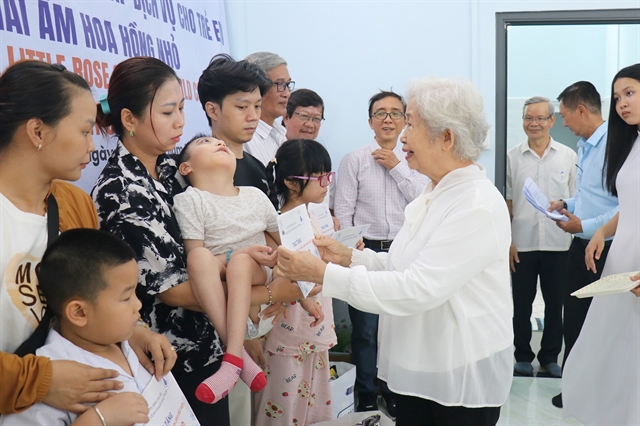 Society
Society

Now the week-long Tết (Lunar New Year) holiday has ended and schools have resumed, many classrooms in mountainous localities still feel strangely empty as local students have not returned.
 |
| A teacher at a school in Tây Trà district pays a visit to students at home to entice them back to school after the holiday.-- Photo dantri.com.vn |
HÀ NỘI — Now the week-long Tết (Lunar New Year) holiday has ended and schools have resumed, many classrooms in mountainous localities still feel strangely empty as local students have not returned.
Apart from teaching duties, teachers in upland areas in Yên Bái and Quảng Ngãi provinces need to take on another assignment – working with local authorities and parents of ethnic minority groups to encourage the children – mostly at pre-school, primary and secondary school levels – to return to class on schedule.
Lang Thíp primary school in Văn Yên District of Yên Bái reported that 20 out of total 712 school students had not showed up to class.
According to Nguyễn Bá Dũng, Principal of Lang Thíp school, the reasons for these post-Tết no-shows are familiar.
Many ethnic groups’ new year traditions are longer than the official one-week holiday and there might still be important events to be done so the families want their children to stay back.
“For Tết, ethnic minorities often organise festivals so children take part in events. Additionally, as per traditional customs of some ethnic minorities, children will only be allowed to leave home after the fifteenth day of the lunar new year,” Dũng said.
Meanwhile, the official date for school resumption this year falls on the seventh day of the lunar new year, or Monday last week on the standard calendar.
Most students coming back to school late were from extremely poor backgrounds in remote and mountainous districts of Văn Chấn, Trạm Tấu, Mù Cang Chải and Văn Yên. The children might need to stay home and take care of farming or household chores for their families.
In addition, some might not be able to afford trips to schools far away from their home, given the sparse concentration of population in the uplands.
Therefore, in many remote and mountainous areas, it has become a familiar task on the first school-day after Tết for teachers to visit families in groups to entice children back to school.
Ly Seo Lâu, a father of three living at Lang Thíp Commune, said when his family was visited by the local authorities and teachers, he agreed to take all three children back to school after Tết.
In recent years, Lang Thíp primary boarding-school has received attention from local authorities and social associations, with infrastructure and policies for students improving.
The primary boarding-school of Chế Cu Nha Commune, Mù Cang Chải District in Yên Bái Province has a total of 816 students, of which, 565 are semi-boarding students.
The teachers here also need to make home visits on Sunday last week, the sixth day of the new year and the last day of the Tết holiday, to ensure full classes on Monday.
They would need to maintain a list of absentees to constantly check and pay second and further home visits, if needed.
Lê Tiến Dũng, Principal of the Chế Cu Nha Commune primary boarding-school said that thanks to the efforts of the school teachers, over three days (Monday to Wednesday), 90 per cent of students have come back to class. It is expected that within the next week, all students will have returned.
Vương Văn Bằng, Director of the Yên Bái Province’s education department, said right after the long holiday, on the three first school days after Tết, 95.9 per cent of students have come back to school.
Of which, the pre-school children reached 91 per cent; primary school students reached 98.3 per cent and junior secondary students of 96.4 per cent, high school students of 98.3 per cent.
The provincial education department has established education inspection groups to check the presence of students, especially in upland districts. At the same time, the schools were required to review and make lists of students who haven’t yet returned to class, so education inspectors would coordinate with local authorities to take proper measures.
The absence of students after Tết is also a cause for concern of authorities in the central province of Quảng Ngãi.
Bùi Thế Giới, head of the education department of Sơn Tây District, said many solutions to prevent this situation had been implemented by schools and local authorities, including pre-Tết information campaigns and keeping close contact with local authorities and students’ parents.
Although many efforts had been made, the number of students who were absent from school after the holiday in the district was still quite high. Until Wednesday, it was recorded that 500 students hadn’t yet come back to school.
Tây Trà mountainous district had also faced the same situation as 300 students hadn’t yet come back to school in the first week after Tết, even though this was a significant improvement from last year with 450 absentees.
Phạm Sơn, head of the district’s education department said that traditional customs aside, many children were simply not in the mood to return to classes.
Deputy head of Quảng Ngãi’s education department, Đỗ Văn Phu, said that the six mountainous districts in the province reported lower numbers of absentees this year.
“Utmost efforts would be made to make sure the students will return, and minimise cases where students’ long absence leads to dropping out of school completely,” Phu said. — VNS




